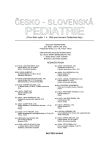-
Medical journals
- Career
Prognosis of Idiopathic Pulmonary Hemosiderosis at the Child Age
Authors: Š. Rosipal 1; A. Kapellerová 2; M. Tamášová 1
Authors‘ workplace: Detské oddelenie NsP, Poprad primár MUDr. Š. Rosipal 1; 2. Detská klinika LFUK a DFNsP, Bratislava prednosta prof. MUDr. L. Kovács, DrSc., MPH 2
Published in: Čes-slov Pediat 2005; 60 (1): 14-18.
Category: Original Papers
Overview
Objective:
To determine the survival of patients with idiopathic pulmonary hemosiderosis (IPH), to analyze the clinical course and mortality in relation to interval between the beginning of manifestations and establishment of diagnosis. The aim was to evaluate prognosis in relation to the choice of therapeutic regiment and duration of treatment.Patients and methods:
A retrospective study in children with the diagnosis of IPH by a questionnaire for the period of 1985–2003 addressed five children’s pneumological outpatient departments in the Slovak Republic. From 16 questionnaires is became necessary to exclude two incomplete questionnaires and one patient with the Goodpasture syndrome. IPH was diagnosed 13-times in the given period of time.Results:
The mean age at establishment of diagnosis was 5.3 ± 3.4 years (range 0.7–13.1), the ratio of boys to girls was 5 : 8. The predominant symptoms included hypochromic anemia (100 %), lung infiltrates (77 %), picture of interstitial changes on the lungs (23 %), fever (72 %), and hemoptysis (23 %). The diagnosis was confirmed by a positive finding of siderophages (92 %) in bronchoalveolar lavage (BAL) and stomach fluid (54 %), only BAL (23 %), in gastric aspiration (8 %) and lung biopsies (8 %). In one case the diagnosis was established only on the basis of clinical manifestations (8 %). The average time of observation of the affected children was 3.7 ± 2.3 years (range 0.3–7.6). The 13 years old girl died during a massive bleeding into lungs with dysfunction of myocardium two weeks after the correct diagnosis was established. The lung fibrosis caused the death of a 12 years old girl after five years of unsuccessful therapy. The time period between the first symptoms and diagnosis of IPH represented 2.8 ± 2.4 years (range 0.3–8.1). The initial treatment consisted of intravenous pulse doses of methylprednisolon (23 %), or in combination of prednisone with inhalation corticosteroids (77 %). The patients favorably responded to long-term (2.5 years on the average) administration of both forms of corticosteroids. In three cases it became necessary to extend the treatment to further immunosuppressives (azothioprin, cyclophosphamide) or hydrochloroquine in order to improve the control of bleeding into lungs, and to slowdown the progression of fibrous changes (23 %). Seven patients survived more than 2.5 years, as expressed by the Kaplan-Meier method (58 %).Conclusion:
The prognosis in patients with a short time period between the first symptoms and established diagnosis of IPH is more favorable. A combined treatment with oral and inhalation corticosteroid or with a simultaneous administration of other immunosuppressives improves the patient’s expectations, decreases the intensity and frequency of sudden pulmonary emergencies, and inhibits chronic pathological events in the lung tissue. It is possible to say that a long-term and complex therapeutic procedure positively influence the prognosis of IPH. The levels of serum erythropoietin are a good index of the phase of the disease, but not of fibrotization progression for showing a direct relationship to the degree of pulmonary bleeding. The presence of ANCA and other auto-antibodies may indicate an unfavorable prognosis.Key words:
idiopathic pulmonary hemosiderosis, corticosteroids, immunosuppressives, prognosis
Labels
Neonatology Paediatrics General practitioner for children and adolescents
Article was published inCzech-Slovak Pediatrics

2005 Issue 1-
All articles in this issue
- Genetic Polymorphisms of UGT 1A1*28 in the TATA-box Promoter Region of Bilirubin Uridinediphosphate-glucuronosyltransferase Gene in Children with Gilbert’s Syndrome
- Prognosis of Idiopathic Pulmonary Hemosiderosis at the Child Age
- Vascular Anomalies in Children – a New Classification System, Natural History and Treatment
- Sad Facies, Spinal Malsegmentation, Progressive Vicious Kyphoscoliosis, Multiple Wormian Bones, Basilar Impression – A Novel Syndrome. Report of Two Sisters
- Experience in the Monitoring of Maternal and Neonatal Iodine Supply in the Czech Republic
- Unique Pattern Syndrome of Distinctive Facies, Short Stature, Kyphoscoliosis, Craniosynostosis, Hyperlaxity and Dyslexia
- Czech-Slovak Pediatrics
- Journal archive
- Current issue
- Online only
- About the journal
Most read in this issue- Sad Facies, Spinal Malsegmentation, Progressive Vicious Kyphoscoliosis, Multiple Wormian Bones, Basilar Impression – A Novel Syndrome. Report of Two Sisters
- Genetic Polymorphisms of UGT 1A1*28 in the TATA-box Promoter Region of Bilirubin Uridinediphosphate-glucuronosyltransferase Gene in Children with Gilbert’s Syndrome
- Vascular Anomalies in Children – a New Classification System, Natural History and Treatment
- Unique Pattern Syndrome of Distinctive Facies, Short Stature, Kyphoscoliosis, Craniosynostosis, Hyperlaxity and Dyslexia
Login#ADS_BOTTOM_SCRIPTS#Forgotten passwordEnter the email address that you registered with. We will send you instructions on how to set a new password.
- Career

